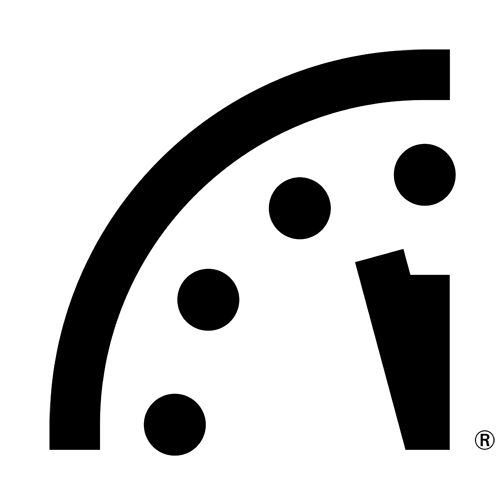
DAVID ADAMS looks at what the ‘Doomsday Clock’ is all about…
News stories appeared around the world recently stating that the hands on the ‘Doomsday Clock’ had moved to two-and-a-half minutes to midnight, the closest it’s been to the symbolic global catastrophe since the early 1950s and the height of the Cold War. But just what is the Doomsday Clock and why does it attract such attention when its famous minute hand moves? Here’s 10 things you may not have known about it…

PICTURE: Courtesy Bulletin of the Atomic Scientists
• The clock was created by the Chicago-based Bulletin of the Atomic Scientists in 1947 as a “arbiter of the planet’s health and safety”. The bulletin had been founded two years before, in 1945, by Manhattan Project scientists.
• The clock first appeared as a graphic on the magazine’s first cover (it had previously been distributed as a newsletter) and was set at seven minutes to midnight.
• The magazine cover – including the clock – was designed by artist Martyl Langsdorf who had also considered using the chemical symbol of uranium on the cover but decided in favour of the clock to suggest time was running out with regard to the management of nuclear arms. She says she set it at seven minutes to midnight only because “it looked good to my eye”.
• While the clock was initially viewed as a symbolic way of representing the threat of nuclear war to the world, the clock’s position also takes into account the impacts of climate change and bio-security threats and other technologies that could pose a threat big enough to lead to global catastrophe.
• In the early years, the setting of the clock was decided by Bulletin editor Eugene Rabinowitch but the Bulletin’s science and security board took over the job when he died in 1973. They meet twice a year to discuss world events and move the clock if necessary, according to whether the planet is safer or more dangerous that the previous year.
• The clock’s minute hand has been moved a total of 22 times since it was “turned on”. The biggest movement was when it jumped seven minutes in 1991 (see below for why).
• The closest the clock has ever come to midnight – two minutes to midnight – was in 1953 after both the US and USSR tested their first thermonuclear devices.
• The furthest from midnight the clock has ever been was in 1991 – 17 minutes to midnight, a move which came after the fall of the Iron Curtain and the dissolution of the USSR.
• There is no physical clock. It can be seen on the homepage of the Bulletin.
• The most recent movement of the hand – in January this year – took it from three minutes to two-and-a-half minutes to midnight. This was the first time the hand had moved by an increment less than a minute.





